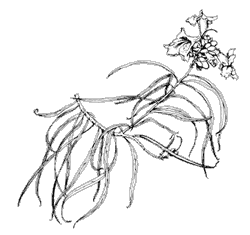Bignoniaceae (bignonia family)
The bignonia family has about 725 mostly tropical species worldwide, of which only four occur in our region. Well-known members include catalpa, jacaranda, and trumpet vine (Campsis radicans).
Chilopsis linearis
English name: desert willow
Spanish names: mimbre (wicker),
jano
Description
Desert willow is a deciduous small tree to 30 feet (9 m) tall that resembles a willow, with its long, narrow leaves and slightly drooping branches. Large flowers shaped like irregular trumpets range from nearly white in the western end of its range to deep purple with yellow nectar guides (visual signals enticing to bees) at the eastern end. Wild trees bloom from mid-spring through midsummer with sufficient rainfall; selected cultivars may bloom into fall with irrigation.
 |
Range
C. linearis occurs from west Texas to southern Nevada, Arizona, southern California, and northern Mexico. Washes from the low desert to grasslands are its primary habitats.Notes
Large bees are the main pollinators, though the flowers are also attractive to other insects and to hummingbirds.
This is one of the few trees in the north half of the Sonoran Desert that is not a legume. Another plant in this family, Tecoma stans (yellow trumpet bush), attains small-tree size in the tropics, but not in the desert. It is a shrub in the north because it periodically freezes to the ground. Tecoma is one of many examples of the Sonoran Desertís tropical legacy.










